Oswestry
| Oswestry | |
| Welsh: Croesoswallt | |
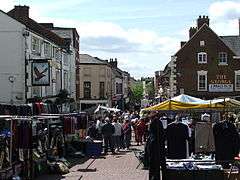 Oswestry Marketplace |
|
 Coat of arms of Oswestry Motto: Floreat Oswestria (May Oswestry flourish) |
|
 Oswestry |
|
| Population | 17,105 (2011 Census) |
|---|---|
| OS grid reference | SJ292293 |
| Civil parish | Oswestry |
| Unitary authority | Shropshire |
| Ceremonial county | Shropshire |
| Region | West Midlands |
| Country | England |
| Sovereign state | United Kingdom |
| Post town | OSWESTRY |
| Postcode district | SY10, SY11 |
| Dialling code | 01691 |
| Police | West Mercia |
| Fire | Shropshire |
| Ambulance | West Midlands |
| EU Parliament | West Midlands |
| UK Parliament | North Shropshire |
|
|
Coordinates: 52°51′35″N 3°03′14″W / 52.8598°N 3.0538°W
Oswestry (/ˈɒzwəstri/; Welsh: Croesoswallt), one of the UK's oldest border settlements, is the largest market town and civil parish in Shropshire, England, close to the Welsh border. It is at the junction of the A5, A483, and A495 roads.
The town was the administrative headquarters of the Borough of Oswestry until that was abolished under local government reorganisation with effect from 1 April 2009. Oswestry is the third largest town in Shropshire, following Telford and Shrewsbury. The 2011 Census recorded the population of the civil parish as 17,105[1] (up almost 10% from 15,613 in 2001) and the urban area as 16,660.[2] The town is five miles (8 km) from the Anglo-Welsh border, and has a mixed Welsh and English heritage.[3] It is the home of the Shropshire libraries' Welsh Collection.[4]
Oswestry is the largest settlement within the Oswestry Uplands, a designated natural area and national character area.[5]
History
It has also been known as, or recorded in historical documents as: Album Monasterium; Blancminster; Blankmouster; Blancmustier; Croes Oswallt; Oswaldestre; Meresberie.[6]
Prehistory
Oswestry's story began with the 3000-year-old settlement of Old Oswestry, one of the most spectacular and best preserved Iron Age hill forts in Britain, with evidence of construction and occupation between 800 BC and AD 43.[7]
The site is also named Caer Ogyrfan or The City of Gogyrfan, the father of Guinevere in legend.
Saxon times
The Battle of Maserfield is thought to have been fought there in 642, between the Anglo-Saxon kings Penda of Mercia and Oswald of Northumbria. Oswald was killed in this battle and was dismembered; according to legend, one of his arms was carried to an ash tree by a raven, and miracles were subsequently attributed to the tree (as Oswald was considered a saint). Thus it is believed that the name of the site is derived from a reference to "Oswald's Tree". The spring, Oswald's Well, is supposed to have originated where the bird dropped the arm from the tree. Offa's Dyke runs nearby to the west.
The Conquest
The Domesday Book (1086) records a castle being built by Rainald, a Norman Sheriff of Shropshire: L'oeuvre ("the work" in French) – see Oswestry Castle.
Alan fitz Flaad (died c.1120), a Breton knight, was granted the feudal barony of Oswestry[8] by King Henry I who, soon after his accession, invited Alan to England with other Breton friends, and gave him forfeited lands in Norfolk and Shropshire, including some which had previously belonged to Ernulf de Hesdin (killed at Antioch while on crusade) and Robert of Bellême.[9]
Alan's duties to the Crown included supervision of the Welsh border. He also founded Sporle Priory in Norfolk. He married Ada or Adeline, daughter of Ernulf de Hesdin.[10][11] Their eldest son William FitzAlan was made High Sheriff of Shropshire by King Stephen in 1137. He married a niece of Robert of Gloucester.[12] But two of their younger sons, Walter and Simon, travelled to Scotland in the train of King David I, Walter becoming the first hereditary High Steward of Scotland and ancestor of the Stewart Royal family.
Border town
The town has many Welsh language street and place names and the town's name in Welsh is Croesoswallt, meaning "Oswald's Cross". It eventually became known as Oswald's Tree in English, from which its current English name is probably derived. The town changed hands between the English and the Welsh a number of times during the Middle Ages. In 1149 the castle was captured by Madog ap Maredudd, and it remained in Welsh hands until 1157. Occasionally in the 13th century it is referred to in official records as Blancmuster (1233) or Blancmostre (1272), meaning "White Minster".[13] Later, Oswestry was attacked by the forces of Welsh rebel leader Owain Glyndŵr during the early years of his rebellion against the English King Henry IV in 1400; it became known as Pentrepoeth or "hot village" as it was burned and nearly totally destroyed by the Welsh. The castle was reduced to a pile of rocks during the English Civil War.
Market town

In 1190 the town was granted the right to hold a market each Wednesday.[14] With the weekly influx of Welsh farmers the townsfolk were often bilingual. The town built walls for protection, but these were torn down in the English Civil War by the Parliamentarians after they took the town from the Royalists after a brief siege on 22 June 1644, leaving only the Newgate Pillar visible today.
After the foot and mouth outbreak in the late 1960s the animal market was moved out of the town centre. In the 1990s, a statue of a shepherd and sheep was installed in the market square as a memorial to the history of the market site.
Military
Park Hall, a mile east of the town, was one of the most impressive Tudor buildings in the country. It was taken over by the Army during World War I in 1915 and used as a training camp and military hospital. On 26 December 1918 it burnt to the ground following an electrical fault. The ruined hall and camp remained derelict between the wars,[15] the camp hospital, however, was still in use; the Baschurch Convalescent and Surgical Home moved there in February 1921 and it became known as the Robert Jones and Agnes Hunt Orthopaedic Hospital.[16]
One of the main uses of the land from the 1920s was for motorcycle racing and it became quite a well-known circuit.[16]
The camp was reactivated in July 1939 for Royal Artillery training and the Plotting Officers' School.[16] Following World War II, Oswestry was a prominent military centre for Canadian troops, then for the British Royal Artillery, and finally a training centre for 15 to 17-year-old Infantry Junior Leaders. The camp closed in 1975. During the 1970s some local licensed wildfowlers discharged their shotguns at some passing ducks and were shot themselves by a young military guard, who had mistaken them for an attacking IRA force.[16]
The area previously occupied by the Park Hall military camp is now mainly residential and agricultural land, with a small number of light industrial units. Park Hall Farm became a visitor attraction in 1998, it is home to the Museum of the Welsh Guards.[16][17] The Park Hall Football Stadium (home of The New Saints FC) and The Venue (including bowling, gym and restaurant) are also on the site.[18]
Landmarks
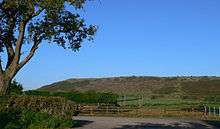
Old Oswestry, situated on the northern edge of the town, dominates the northern and eastern approaches. The 3000-year-old settlement of Old Oswestry, is one of the most spectacular and best preserved Iron Age hill forts in Britain, with evidence of construction and occupation between 800 BC and AD 43.[7]
The site is also named Caer Ogyrfan or The City of Gogyrfan, the father of Guinevere in legend.
Other attractions in and around Oswestry include: Whittington Castle (in nearby Whittington), Shelf Bank and the Cambrian Railway Museum located near the former railway station.
The town is famous for its high number of public houses per head of population; there are around 30 in the town today, many of which offer real ale. A story incorporating the names of all of the pubs once open in Oswestry can be found hanging on a wall inside The Oak Inn on Church Street. There is a tapestry of 40 Oswestry pub signs on display in the town's Guildhall on the Bailey Head.
Brogyntyn Hall which belonged until recently to the Lords Harlech lies just outside the town.[19]
Culture
While other towns in Shropshire have developed a food reputation, Oswestry has developed an increasingly varied cultural reputation.
Drama and film
- The Attfield Theatre is based in the town's Guildhall. It traces its origins back to 1928. The theatre produces several plays each year.[20] The Oswestry Musical Theatre Company also organises regular performances in the town.[21]
- Llanymynech Amateur Dramatic Society, five miles away on the A483. LADS produces three productions every year, including tours and open air performances.
- Qube is a community arts organisation.[22] It organises various activities on a regular basis.
- Fusion Arts organises a wide range of arts and music activities for young people.[23]
- Kinokulture is Oswestry's boutique cinema which operates out of a renovated church hall near the town centre.[24] It organises a regular programme of films and live performances. It also organises a Saturday morning Kids' Club.
Music
There is a rich musical heritage in Oswestry. The town was the home of the composer Henry Walford Davies who became the Master of the King's Musick. Musical societies include the Oswestry Choral Society and the Oswestry Recorded Music Society. Recently the Oswestry Ladies Choir has developed.[25]
Literature
Oswestry was the birthplace of Wilfred Owen, the First World War poet. A civic park named Wilfred Owen Green was opened in the town in 2010 by his nephew Peter Owen and has a 40m labyrinth, one of the largest in the world.[26] There is also a plaque and stone bench dedicated to the poet in the town centre.
Oswestry is also the birthplace of Barbara Pym, an English novelist most famous for a series of social comedies she published in the 1950s, of which the best known are 'Excellent Women' and 'A Glass of Blessing'.
It is the hometown of contemporary writer Edouard d'Araille, author of poetry, fiction and philosophy volumes including 'Words Can't Hold…' (2006), 'General Store' (6 Vols.) and 'The Cosmic Mirror: Being, Life, Art and the Cinema of 6 Dimensions' (2000). His renowned 2005 war poem 'The Fallen' is dedicated to fellow Oswestrian Wilfred Owen.
Booka bookshop[27] is an award-winning local bookstore located in the centre of Oswestry.
Visual arts
Oswestry and surrounding area is home to a large number of visual artists. Borderland Visual Arts[28] and InsideOut Arts[29] are informal networks of artists resident in the area. They organise regular exhibitions in different venues.
The Willow Gallery[30] is a hub for creative activity in Oswestry. It is a contemporary art space displaying works by local and international artists. It also organises workshops, talks and other events.
Festivals
Oswestry LitFest[31] was established in 2000 and has grown steadily since. It is an annual event taking place during two weeks in March. A wide variety of talks and workshops take place around the town.
The Oswestry Youth Music Festival takes place in February/March of each year. There are 74 competitive classes for young musicians for all ages up to 21 years. The Oswestry Recital Series which is organised by Oswestry School takes place throughout the year and includes performances by such performers as the Royal String Quartet and the City of London Sinfonia.
Borderlines Film Festival[32] takes place across thirty venues in Shropshire and Herefordshire. During two weeks in Spring several dozen carefully selected films are screened. Often they are followed by talks by invited speakers. In Oswestry, Kinokulture is actively involved in this festival.
The Oswestry Food and Drink Festival takes place in July each year.[33]
Language
Oswestry was traditionally a Welsh speaking town and the parish church conducted services in Welsh until 1814.[34] English is the dominant language today, but there are still some Welsh speakers. Oswestry has one of the few Welsh-language bookshops outside Wales.[35]
Religion
In the 2011 Census, 68.7% of the population of Shropshire stated that their religion was 'Christian'. The second largest group (22.8%) stated that they had 'no religion'.[36]
.jpg)
There are a number of places of worship in Oswestry. There are two Church of England churches, which are part of the Diocese of Lichfield: St Oswald's Parish Church and the Holy Trinity Parish Church. St Oswald's Church was first mentioned in the 1085 Domesday book and a tithe document in Shrewsbury the same year.[37] St Oswald's Church is Grade II* listed, having a tower dating from late 12th or early 13th century and later additions particularly in the 17th and 19th centuries.[38] There is a new window in the east nave, designed by stained glass artist Jane Grey in 2004.
The town of Oswestry and surrounding villages fall into the parish of Our Lady Help of Christians and St Oswald, in the Roman Catholic Diocese of Shrewsbury. The single Catholic church is Our Lady and St Oswald's Catholic Church.[39] There is an associated primary school.[40]
There are two Methodist churches: the Horeb Church on Victoria Road and the Oswestry Methodist Church. Cornerstone Baptist Church is on the corner of Lower Brook Street and Roft Street in a modern 1970s building. Other Nonconformist churches include the Albert Road Evangelical Church, the Carreg Llwyd Church ("Grey Rock"), founded in 1964, and the Cabin Lane Church, established by members of the Carreg Llywd Church in 1991 following the eastern expansion of Oswestry.[41]
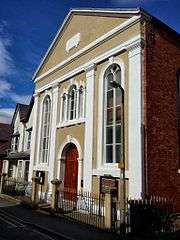
Christ Church, now a United Reformed Church but formerly Congregationalist, was the home church of British composer Walford Davies.[42] There is a Welsh-speaking church, the Seion Church, and the Holy Anglican Church, a Western Rite Anglican establishment. Coney Green has a Jehovah's Witness Kingdom Hall. The Religious Society of Friends also holds meetings in Oswestry. The Grade II* star Hermon Chapel, by chapel architect Thomas Thomas, was a Welsh-speaking Congregational church[43] and is now an arts and community centre.
A small Muslim community exists in the town. A plan to transform a 19th-century former Presbyterian church on Oswald Road into a permanent base for meetings and prayer services fell through in March 2013 due to the cost.[44]
Healthcare
The Robert Jones and Agnes Hunt Orthopaedic Hospital NHS Trust in Oswestry provides elective orthopaedic surgery and musculoskeletal medical services.[45] The hospital is located towards Gobowen.
There is a Minor Injuries Unit on Thomas Savin Road, near the bus station.
Education
Oswestry is home to the second oldest 'free' (which in this context means not linked to any ecclesiastical foundation) school in the country, Oswestry School, which was founded in 1407. (The oldest, Winchester College, was founded in 1382.)[46] Oswestry School's 15th century site, adjacent to St Oswald's Parish Church, is now a heritage centre, housing the Tourist Information Centre, Shropshire Poacher Coffee Shop, and exhibitions.[47][48]
There are several primary schools such as Our Lady's Primary School, St Oswald's Catholic Primary School and Woodside Primary School, which became an academy on 1 May 2013. Secondary education is covered by two independent schools, Moreton Hall School (for girls) and the aforementioned Oswestry School (co-educational), and a comprehensive secondary school, The Marches School, which is also an academy. Further education is provided by North Shropshire College which is situated in the town at Shrewsbury Road and at the Walford Campus near Baschurch.
Transport
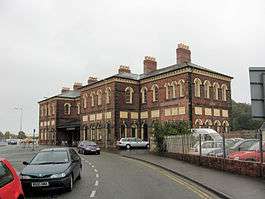
Oswestry is at the junction of the A5 with the A483 and A495. The A5 continues from Shrewsbury to the north, passing the town, before turning west near Chirk and entering Wales.
Bus services are operated by Arriva Midlands and local independents Tanat Valley Coaches and Bryn Melyn. The town has regular bus routes that link nearby villages and towns including Wrexham and Shrewsbury.
Canals
The Llangollen Branch of the Shropshire Union Canal runs from Ellesmere to Llangollen, running 4.5 miles east of the town at Hindford and on through Chirk, 6 miles north. A navigable section of the partially restored Montgomery Canal, runs from Frankton Junction (connecting to the Llangollen Branch of the Shropshire Union Canal) to Newtown.[49]
Historic railways
The railway station, once on the main line of the Cambrian Railways, was closed as a consequence of the 1960s' Beeching Report on British Railways. Opened in 1840, the section from Whitchurch to Welshpool (Buttington Junction), via Ellesmere, Whittington, Oswestry and Llanymynech, closed on 18 January 1965 in favour of the more viable alternative route via Shrewsbury, leaving only a short branch line of the former Great Western Railway from Gobowen to continue to serve Oswestry – but only until 7 November 1966. The GWR branch had once run into a separate GWR Oswestry terminus, but this has long since disappeared and the land redeveloped as a bus terminus and supermarket. Trains were switched to the main Cambrian station from 7 July 1924.
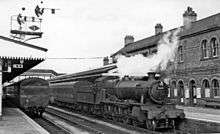
The main building of the Cambrian station is still a prominent landmark in the town centre: it once housed the headquarters of the Cambrian Railways company. After restoration, this building was reopened as the Cambrian Visitor Centre in June 2006 but closed on 11 January 2008. It later reopened, and has since evolved into the headquarters of the Cambrian Heritage Railways (CHR) and a small catering establishment known as "Buffers"; other parts of the building have been converted into retail and office units to contribute to the upkeep of the building.
A single railway track still running through the station, once overgrown and rusting, has been cleared and repaired and is the subject of an ambitious plan to reopen the line as a steam heritage railway between Oswestry and Llanyblodwel and Pant (to link with the restored Montgomery Canal – see above), and as a sustainable community transport rail link from Oswestry to the UK network main-line railway station at Gobowen.
By 2013, the main "up" platform at Oswestry station had been reconstructed and some new semaphore signalling installed. The branch-line track-bed from south of Gobowen to Llanyblodwel is now owned by Shropshire Council, who lease the land to Cambrian Heritage Railways (CHR), a registered charity. Work is advancing in securing the transfer of the existing Transport & Works Act Order (TWAO) from UK Network Rail to the CHR. The aim was for this transfer to be completed by 2014, and for the railway line between Gobowen and Oswestry to be fully re-instated and operational by 2017; however the legal process of the TWAO Unit administering a form of written debate between the proposer and objectors with a guided number of exchanges, was still ongoing in mid 2016. CHR purchase of the final section of the Oswestry to Gobowen railway branch line was completed in April 2016; nevertheless, other hurdles to becoming operational, such as permissions and finances to reinstate the level crossings on the main A5/A483 Trunk Roads, will also need to be overcome.
Immediately to the south of Oswestry Railway Station is the Cambrian Railways Museum; while a short distance to the north are the "listed" Works Bridge and the former Cambrian Railways works, which are now occupied by a variety of local commerce concerns and Oswestry's Community Health Centre and ambulance facility.
Sport

The former local football club, Oswestry Town F.C., was one of the few English teams to compete in the League of Wales. It also won the Welsh Cup in 1884, 1901 and 1907.[50] The club folded due to financial difficulties in 2003 and merged with Total Network Solutions F.C. of Llansantffraid, a village eight miles (13 km) away on the Welsh side of the border. Following the takeover of the club's sponsor in 2006, the club was renamed as the New Saints. They moved to the redeveloped Park Hall Stadium on the outskirts of the town in September 2007. Oswestry Lions F.C. of the Shropshire County League also play at the ground.
Oswestry Cricket Club compete in the Birmingham and District Premier League which is the oldest cricket league in the country. The club, whose former player Andy Lloyd went on to captain Warwickshire and also to play for England, play at their Morda Road ground to the south of the town.
Oswestry Olympians Athletic and Triathlon club has a strong base in the town with 120+ members. One of Its founders John Disley was a co-founder of the London Marathon. The club puts on several local races including a 5k at Park Hall, a 10k at Ellesmere and a Triathlon in Oswestry itself. Members also compete with regular success in the North Wales Cross Country League with the Vet 40 team winning in 2015/16.
Recreation and leisure
From the 1700s to 1848, there was a popular racecourse outside the town. Known as Cyrn-y-Bwch, the site was chosen on this 1000-foot (above sea-level) hilltop because of its location between the Kingdom of England and the Principality of Wales, and the aim was to bring together the local landowners and gentry of Wales and England. Remnants of the old grandstand and figure-of-eight racetrack can still be seen.[51]
Nowadays, Oswestry Race Course is common land, registered under the Commons Act 1899 and the CROW Act 2000, with a number of rights of way on the South Common including Offa's Dyke Path and Bridleway. Also designated as a publicly accessible open space and a Wildlife Site in the 1999 Local Plan, it is an area reserved for:
- quiet, informal leisure activities and recreation;
- the biological diversity of the matrix of heathland, sparse woodland, ponds and ditches; and
- the sustainable management and conservation of nature and wildlife.
The site provides extensive views across the surrounding landscape of England and Wales.
The Llanymynech to Chirk Mill section of Offa's Dyke Path (a national trail) crosses the common.[52]
For children, Oswestry Youth Cafe and the Centre offer many sessions for entertainment.
Notable people
- Frank Bough, British television presenter
- Thomas Bray, theologian
- Shirley Brooks, journalist and novelist, lived there when training as a solicitor 1832–38
- Brigadier-General John Vaughan Campbell, World War I Victoria Cross winner, at a house called Broom Hall prior to 1939
- Sir Henry Walford Davies, composer
- Matt Done, footballer for Sheffield United
- Peter Edwards, BP Portrait Award-winning artist
- Paul Evans, footballer
- Carl Griffiths, footballer
- Sir Francis Humphrys, first British Ambassador in Baghdad, born at Beatrice Street when his father was a master at Oswestry School.
- Ian Hunter, musician – Mott the Hoople, etc.
- Di Jones, Welsh international footballer
- Mark Laff, drummer of the rock band Generation X
- Per Lindstrand, balloonist
- Philip Llewellin, journalist and writer
- Andy Lloyd, England test cricketer and captain of Warwickshire CCC
- Alexander Macmillan, 2nd Earl of Stockton, Chairman of Macmillan Publishing Ltd
- Boaz Myhill, footballer
- Charlie Morris, Welsh international footballer
- Wilfred Owen, World War I soldier and poet
- Roger Palmer, 1st Earl of Castlemaine, diplomat and courtier, died at Oswestry 1705.
- Barbara Pym, author
- Gordon Jackson Rees, pediatric anesthesiologist
- Trevor Rees-Jones, bodyguard and survivor of the accident in which Diana, Princess of Wales died
- Herbie Roberts, footballer
- Mark Robinson, former cricketer; now pub singer
- Thomas Savin, railway engineer, buried Oswestry Cemetery
- Dame Stephanie Shirley, businesswoman and philanthropist, lived at Oswestry for six years as child and attended Oswestry Girls' High School.[53]
- William Archibald Spooner, originator of the Spoonerism, educated at Oswestry School
- William Henry Griffith Thomas, clergyman and scholar
- Robert Ussher, Bishop of Kildare – buried at Doddleston Chapel, near Oswestry
- Edward Weston, chemist
- Harold Whitfield, World War I Victoria Cross-winning soldier – born in the town, buried Oswestry Cemetery
- George Williams, Michigan state senator
- Ian Woosnam, golfer
- George Wynn, Welsh international footballer
References
- ↑ Population Density, 2011, Neighbourhood Statistics, 2011 Census, Office for National Statistics, retrieved 3 September 2014
- ↑ "Oswestry". World Gazetteer. Retrieved 14 May 2008.
- ↑ Shropshire Tourism. "Oswestry & the Welsh Borders". Retrieved 3 March 2009.
- ↑ Shropshire Council. "Welsh Collection at Oswestry Library". Retrieved 3 March 2009.
- ↑ NCA 63: Oswestry Uplands Key Facts & Data at www.naturalengland.org.uk. Accessed on 5 April 2013.
- ↑ "Gatehouse Gazetteer – Oswestry". Gatehouse Gazetteer.
- 1 2 "History of Old Oswestry Hill Fort". English Heritage.
- ↑ Burke, Messrs., John and John Bernard, The Royal Families of England, Scotland, and Wales, and Their Descendants &c., volume 2, London, 1851, p. xl.
- ↑ Ritchie, R. L. Graeme, The Normans in Scotland, Edinburgh University Press, 1954, p.280-1
- ↑ Round, J. H., Studies in Peerage, p.123
- ↑ Ritchie (1954) p.98n and 280-1
- ↑ Ritchie (1954) p.281
- ↑ E. Ekwall, 'Concise Oxford Dictionary of English Place-Names', 4th ed., 1960
- ↑ "Oswestry Market". Shropshire Tourism.
- ↑ Shropshire Routes to Roots. "Introduction to Park Hall". Shropshire County Library Service.
- 1 2 3 4 5 "Gazetteer of Sites: Park Hall Barracks, Oswestry (SJ3031)". Shropshire History.
- ↑ "The Welsh Guards Collection: The Official Welsh Guards Museum". Welsh Guards. Retrieved 27 March 2015.
- ↑ "Park Hall Stadium". New Saints FC.
- ↑ John S Turner. "Brogyntyn Hall, near Oswestry (C) John S Turner :: Geograph Britain and Ireland". geograph.org.uk. Retrieved 17 May 2015.
- ↑ "Attfield Theatre – Welcome!". attfieldtheatre.co.uk. Retrieved 17 May 2015.
- ↑ "omtc.info". omtc.info. Retrieved 17 May 2015.
- ↑ http://www.qube-occa.org.uk
- ↑ "Fusion Arts Oswestry – Opening the Arts to Everyone". fusionartsoswestry.co.uk. Retrieved 17 May 2015.
- ↑ "HOME – Oswestry's Community Cinema". kinokulture.org.uk. Retrieved 17 May 2015.
- ↑ "Oswestry Ladies Choir". Retrieved 12 November 2016.
- ↑
- ↑ "Welcome to Booka". Booka Bookshop. Retrieved 17 May 2015.
- ↑ "Home page at Borderland Visual Arts – a networking artists group in Shropshire". borderlandvisualarts.com. Retrieved 17 May 2015.
- ↑ "Inside Out Art Group". Inside Out Art Group. Retrieved 17 May 2015.
- ↑ [willowgalleryoswestry.workpress.com]
- ↑
- ↑ "Borderlines Film Festival". Borderlines Film Festival. Retrieved 17 May 2015.
- ↑ "Oswestry Food Festival". oswestryfoodfestival.co.uk. Retrieved 17 May 2015.
- ↑ "Popeth Yn Gymraeg website (Welsh)".
- ↑ "Siop Cwlwm Website".
- ↑ Office of National Statistics
- ↑ "St Oswald Church Oswestry – Church History". stoswaldsoswestry.org.uk. Retrieved 17 May 2015.
- ↑ "Church of St Oswald, Oswestry". British Listed Buildings. Retrieved 7 February 2016.
- ↑
- ↑ "Home Page". osoprimary.co.uk. Retrieved 17 May 2015.
- ↑ "Cabin Lane Church – Who are we?". Cabin Lane Church. Retrieved 27 March 2015.
- ↑ "Christ Church – Picture and Notes". Retrieved 31 December 2007.
- ↑ "Hermon Chapel, Oswestry". British Listed Buildings. Retrieved 7 February 2016.
- ↑ "Muslim prayer centre plan for church dropped". Shropshire Star. 5 April 2013. p. 1.
- ↑ "History of Oswestry Orthopedic Hospital". NHS.
- ↑ "History - Oswestry School". oswestryschool.org.uk. Retrieved 10 August 2016.
- ↑ "Oswestry Town Council: Visitor and Exhibition Centre". www.oswestry-tc.gov.uk. Retrieved 10 August 2016.
- ↑ "Welcome to Oswestry". www.oswestry.com. Retrieved 10 August 2016.
- ↑ Lewery, Tony. "The Montgomery Canal". Canal Junction. Retrieved 18 January 2008.
- ↑ "Welsh Cup " Champions". worldfootball.net. Retrieved 17 May 2015.
- ↑ Greyhound Derby "Oswestry racecourse". Date retrieved: 14/8/13
- ↑ "Hikeview Offa's Dyke Page". Hikeview.co.uk. Retrieved 9 September 2013.
- ↑ "Dame Stephanie to return to Oswestry". Shropshire Star. 1 April 2015. p. 23.Report by Sue Austin. She was about to attend Oswestry Literary Festival to promote her autobiography and said of her time, "In Oswestry I had six wonderful years of peace" after World War II.
External links
| Wikimedia Commons has media related to Oswestry. |
| Wikivoyage has a travel guide for Oswestry. |
- Oswestry Hospital – OsCell
- Oswestry Town Council
- Oswestry Borough Council
- 107.1 FM | The Severn
- Oswestry & Border Counties Advertizer Newspaper
- Oswestry Landmarks and Tourism
- Oswestry & Border History & Archaeology Group - OBHAG
- Guide to Oswestry History and Archaeology
- Annual Oswestry Agricultural Show
- The Oswestry Food Festival
- The Oswestry Festival of the Word